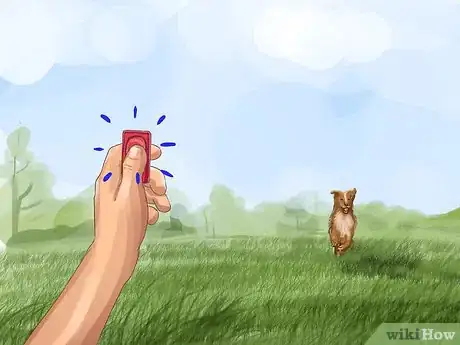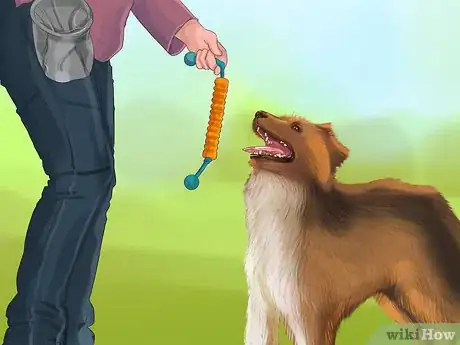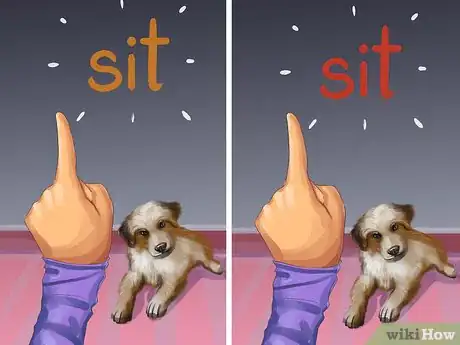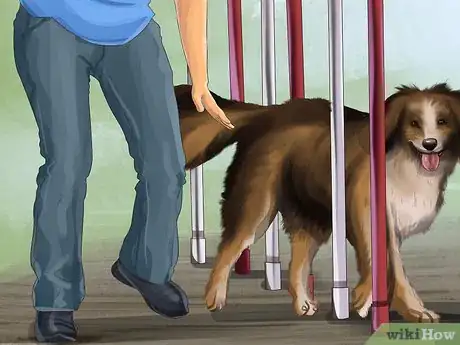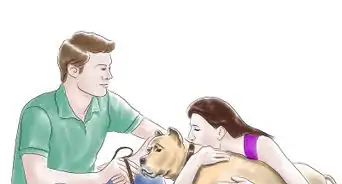This article was co-authored by Ty Brown. Ty Brown is a Dog Behaviorist and Trainer and the Owner of Ty the Dog Guy, a business that provides dog training through digital resources (podcasts, web series, and online courses) along with in-person dog training. Ty has over 17 years of experience in dog training and specializes in both mitigating unruly pet behavior and service dog training. Ty has been awarded the "Best of State Award" for dog training in Utah ten times and his work has been featured in ABC, NBC, CBS, Spike TV, and Entrepreneur Magazine.
There are 8 references cited in this article, which can be found at the bottom of the page.
wikiHow marks an article as reader-approved once it receives enough positive feedback. In this case, 91% of readers who voted found the article helpful, earning it our reader-approved status.
This article has been viewed 114,993 times.
Australian shepherds are herding dogs that are popular pets. They are very intelligent dogs that thrive when thoroughly trained. To train an Australian shepherd you should focus on rewarding good behavior and reinforcing training with repetition and consistency. With some time and effort, your Australian shepherd will be a wonderfully trained companion for years to come.[1]
Steps
Setting Up for Success
-
1Socialize your dog at an early age. Dogs that are socialized early are better able to interact with a wide variety of people and function in a wide variety of situations. Take your dog to a wide variety of places where it can interact with a wide variety of people. Showing your dog that strangers and new places are fun and exciting experiences instead of scary ones is an important part to raising a well-rounded dog.[2]
- For example, some things you can do to socialize your dog include taking it to a friend's house, walking it in a neighborhood other than your own, and taking it along on errands to places that allow dogs.
- If you have an Australian shepherd puppy, it's best to start socialization when they are 7 weeks old. Between the ages of 7 weeks and 4 months old a dog goes through a prime socialization period.
- Even if a dog has not been socialized during the prime period between 7 weeks old and 4 months old, that does not mean that it can't be socialized. It just means that it will be harder to get your dog used to a wide variety of people and places.
-
2Practice reward-based training principles. Australian shepherds thrive with reward-based training, also called positive-reinforcement training, that promotes good behavior. Instead of punishing unwanted behavior, this type of training motivates the dog to complete desired behavior by giving it praise or rewards when it does what you want it to do.[3]
- With reward-based training, you give a dog praise or a treat for completing tasks you want it to do, such as sitting when asked, coming when called, and going to the bathroom outside in a timely manner.[4]
- Purchase high-value treats at your local pet supply store to encourage your dog's good behavior.
Advertisement -
3Consider clicker training your dog. Clicker training is a type of training that uses a sound to indicate to the dog when a command has been completed. This is a form of communication that works well with Australian shepherds that will undergo extensive training.[5]
- With clicker training, the trainer gives a verbal command first. The moment the dog completes the command, the trainer clicks the clicker and then gives the dog a treat. This sound occurring at the moment of completion clearly communicates to the dog that they did what they were asked to do, whereas simply giving treats can be interpreted as a reward for any number of previous actions.
Teaching Your Australian Shepherd to Respond to Commands
-
1Start training your dog to perform basic commands, such as sit and lay down. The very beginning of training can be the most difficult part because you need to establish communication with your dog about what you want it to do. In the beginning, wait until the dog is naturally about to do what you want it to do, such as sitting, and then say the word you want to use for that command. After the dog does the action and you have said the word, give it a treat. Every time you notice it beginning to sit, give it praise or a treat after you say the word "sit."[6]
- With repetition, your dog will learn to connect the word you say with its action and it will know that it gets a treat if it does what you ask it to.[7]
- Use treats and praise to encourage the dog's good behaviors. Australian shepherds are highly motivated by treats and praise and are highly intelligent dogs. This will work to your advantage when training them.
- You can also use treats to lure your dog into performing the desired behavior. For example, you can hold a treat and raise it in an arc above your dog's head to get him to sit down. As he sits, label the behavior by saying "sit."
-
2Do short training sessions often. Dogs do best when you provide consistent training but you don't them force them to do long, drawn-out training sessions. Do a training session with your dog every day but only have it last for about 15 to 20 minutes. Short, focused training sessions allow the dog to get consistent training but doesn't set you and the dog up for failure. In a long training session the dog is likely to lose interest and focus, which can be frustrating.
- After the training session is over, take a few minutes to play with the dog. This will end the training session on a good note and thus will make the dog more eager to do the sessions in the future.
-
3Keep your commands consistent. When training a dog you need to focus on clear communication. Pick a specific word for each command you want to teach it and always use the same word. It also helps to say the word in the same way every time, using the same volume and pronunciation consistently .[8]
- For example, when trying to get your dog to go to the bathroom on command pick a consistent command phrase. Don't say "go to the bathroom" one time and "go potty" the next. These different words can confuse a dog about what you want.
- If you begin to get frustrated, the tone of a command can change. To a dog, a kind and happy "sit" can sound a lot different than a frustrated and gruff "sit."
- Using consistent commands allows your dog to learn what you are trying to communicate with it and will allow it to respond to you more reliably.
-
4Work on a wide variety of commands. Because Australian shepherds are so eager and skilled at learning commands, they can really thrive when being continually taught more and more commands. Teach your dog to heel. Teach it to stay and to come. Also teach it to lie down, as well as fun commands, such as to shake hands.[9]
- When teaching new commands, remember to continually reinforce your training on older commands. Refreshing the dog's recollection of its foundational commands will keep it better trained and consistent.
-
5Break down advanced skills into parts. If you are interested in training your Australian shepherd to do complicated skills, you will need to teach it one piece at a time. Show the dog how to do each piece separately, giving treats or praise when they complete it, and then gradually fit the skills together.
- For instance, if you want to train an Australian shepherd to run through an agility course, you will need to teach it each part of the course separately. First it will need to learn how to do jumps, then it will need to learn how to go through tunnels, and so on until it can do each part separately. Once the dog has the parts down, then you can begin putting them together.
- Australian shepherds are very smart and physical dogs, so many of them thrive at complicated skills that take time to learn.
Minimizing Herding Behaviors
-
1Anticipate bad behavior before it occurs. Australian shepherds are notorious herders. In most cases you will want to train them not to do this if they are not an actual working dog. Typically, when an Australian shepherd is getting ready to herd it will exhibit certain behaviors. For example, it may bark at you or sniff a person's heels right before it starts herding them. If you see the behaviors that typically mark the start of herding, this is the time to interrupt the dog's actions and show it that they are unacceptable.[10]
- It is easiest to anticipate herding behavior by taking the time to analyze a dog's actions over time. By taking the time to watch how bad behaviors develop, you can typically identify how they start.
-
2Stop herding behaviors immediately and clearly.[11] It is important to always stop the bad behavior you want to eliminate so that your dog knows that it is never OK. If your dog begins herding or initiates the kinds of behaviors the occur right before herding, stop that behavior immediately by saying "no" and walking away. You should not punish the dog physically or make it scared. The goal is to make it clear that their behavior is unacceptable without making the dog defensive.[12]
- If you let herding occur once in awhile but stop it other times, the dog will assume that herding is OK in some instances. However, it will be confused about when it can do it.
-
3Redirect your dog's energy. When your dog starts to herd, the best way to get it to stop is to redirect it towards doing something else. If you see the first signs of herding, immediately initiate play time or take it out to exercise.[13]
- Redirecting with exercise is a good idea because Australian shepherds need a lot of exercise every day. They should be allowed to run and play outside every day, otherwise their energy will likely be directed towards herding or other bad behaviors. To give them consistent exercise, take them on at least 2 long walks every day or take them to a dog park where they can run around with other dogs.
-
4Consider professional training. If you are not having success getting your Australian shepherd to stop herding you or other people, you may need to get professional help. A professional dog trainer will be able to provide both the consistency and expertise in animal behavior that an Australian shepherd may require.[14]
- Talk to your veterinarian or friends or family in your area who have used a trainer to find a professional in your area. If you cannot get any personal recommendations, search online for professional dog trainers in your area.
Expert Q&A
-
QuestionHow do I teach my puppy commands?
 Ty BrownTy Brown is a Dog Behaviorist and Trainer and the Owner of Ty the Dog Guy, a business that provides dog training through digital resources (podcasts, web series, and online courses) along with in-person dog training. Ty has over 17 years of experience in dog training and specializes in both mitigating unruly pet behavior and service dog training. Ty has been awarded the "Best of State Award" for dog training in Utah ten times and his work has been featured in ABC, NBC, CBS, Spike TV, and Entrepreneur Magazine.
Ty BrownTy Brown is a Dog Behaviorist and Trainer and the Owner of Ty the Dog Guy, a business that provides dog training through digital resources (podcasts, web series, and online courses) along with in-person dog training. Ty has over 17 years of experience in dog training and specializes in both mitigating unruly pet behavior and service dog training. Ty has been awarded the "Best of State Award" for dog training in Utah ten times and his work has been featured in ABC, NBC, CBS, Spike TV, and Entrepreneur Magazine.
Dog Trainer You'll be most successful if you keep a pack of treats on you at all times. That way, as soon as your puppy does something good, you can reward that behavior. It's also helpful to keep your puppy on a leash while you're training it so you can guide it to the behaviors you want it to do.
You'll be most successful if you keep a pack of treats on you at all times. That way, as soon as your puppy does something good, you can reward that behavior. It's also helpful to keep your puppy on a leash while you're training it so you can guide it to the behaviors you want it to do. -
QuestionAre Australian Shepherds loyal?
 Pippa Elliott, MRCVSDr. Elliott, BVMS, MRCVS is a veterinarian with over 30 years of experience in veterinary surgery and companion animal practice. She graduated from the University of Glasgow in 1987 with a degree in veterinary medicine and surgery. She has worked at the same animal clinic in her hometown for over 20 years.
Pippa Elliott, MRCVSDr. Elliott, BVMS, MRCVS is a veterinarian with over 30 years of experience in veterinary surgery and companion animal practice. She graduated from the University of Glasgow in 1987 with a degree in veterinary medicine and surgery. She has worked at the same animal clinic in her hometown for over 20 years.
Veterinarian Yes, Australian Shepherds are loyal dogs. Their working origins mean they automatically look to their owner for guidance. This makes for a bonded dog that is extremely loyal to a person they know and trust.
Yes, Australian Shepherds are loyal dogs. Their working origins mean they automatically look to their owner for guidance. This makes for a bonded dog that is extremely loyal to a person they know and trust. -
QuestionAre Australian Shepherds easy to train?
 Pippa Elliott, MRCVSDr. Elliott, BVMS, MRCVS is a veterinarian with over 30 years of experience in veterinary surgery and companion animal practice. She graduated from the University of Glasgow in 1987 with a degree in veterinary medicine and surgery. She has worked at the same animal clinic in her hometown for over 20 years.
Pippa Elliott, MRCVSDr. Elliott, BVMS, MRCVS is a veterinarian with over 30 years of experience in veterinary surgery and companion animal practice. She graduated from the University of Glasgow in 1987 with a degree in veterinary medicine and surgery. She has worked at the same animal clinic in her hometown for over 20 years.
Veterinarian The Australian Shepherd is a highly intelligent dog. Reward-based training methods are ideal as the breed thrives on encouragement and praise for a job well done. This makes them highly rewarding to train as they love learning.
The Australian Shepherd is a highly intelligent dog. Reward-based training methods are ideal as the breed thrives on encouragement and praise for a job well done. This makes them highly rewarding to train as they love learning.
References
- ↑ http://www.vetstreet.com/dogs/australian-shepherd#personality
- ↑ http://www.akc.org/content/dog-training/articles/puppy-socialization/
- ↑ http://www.humanesociety.org/animals/dogs/tips/dog_training_positive_reinforcement.html
- ↑ Ty Brown. Dog Trainer. Expert Interview. 4 June 2020.
- ↑ http://www.akc.org/content/dog-training/articles/what-is-clicker-training-a-great-way-to-shape-your-dogs-behavior/
- ↑ http://www.humanesociety.org/animals/dogs/tips/dog_training_positive_reinforcement.html
- ↑ Ty Brown. Dog Trainer. Expert Interview. 4 June 2020.
- ↑ http://www.akc.org/content/dog-training/articles/importance-consistency-training-dog/
- ↑ http://www.humanesociety.org/animals/dogs/tips/dog_training_positive_reinforcement.html
- ↑ http://dogtime.com/dog-health/dog-behavior/5436-dog-herds-people-faq-leigh-siegfried
- ↑ Ty Brown. Dog Trainer. Expert Interview. 4 June 2020.
- ↑ http://dogtime.com/dog-health/dog-behavior/5436-dog-herds-people-faq-leigh-siegfried
- ↑ https://books.google.com/books?id=tQS4CgAAQBAJ&lpg=PT176&ots=ba26QW37zG&dq=dog%20eliminate%20herding&pg=PT176#v=onepage&q=dog%20eliminate%20herding&f=false
- ↑ http://www.vetstreet.com/dogs/australian-shepherd#personality
About This Article
To train an Australian Shepherd, start with simple commands like “sit” and “stay,” and use your hands to guide the dog’s movements. When it performs the action that you want it to do, praise it and reward them with a treat or by petting it. Always keep your commands consistent by saying the same word and doing the same motion each time. Keep training sessions to 15-20 minutes, and work on a variety of commands. When you’re finished training, let the dog have some time to play with toys or run to burn off energy. For tips on minimizing herding behavior in Australian Shepherds, scroll down!



